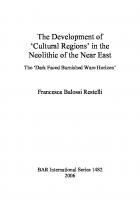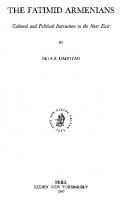The Fatimid Armenians: Cultural and Political Interaction in the Near East 9789004108165
This first study of its kind cuts across and brings together the political and cultural histories of the medieval Near E
264 60 13MB
English Pages 223 Year 1997
Table of contents :
CONTENTS
Introduction 1
I. The Syriac factor in the development of Armenian Christianity and the early sects 17
The Heretics of Sivas and the Council of Gangra 17
The fifth century—The Mẹẓghnēans, the Borborits and the Nestorians 25
The sixth century—The position of the Armenian Church 31
II. The Paulicians and the Muslim factor 36
Origin and the "eastern" roots: Syriac, majūsī, Islamic 36
Politicization: the Muslim alliance and Byzantine deportations 43
Tephrike: the akritic state of the Paulicians in the ninth century 49
III. Armenian sectarians in Upper Mesopotamia and Syria from the ninth to eleventh centuries 54
The Ṭonrakians and Grigor Magistros 54
Sectarians in Upper Mesopotamia and Syria—tenth to eleventh centuries 69
The Arevordiḳ or the Shamsiyya al-Arman in Syria 72
The akritic state of Philaretus the Armenian in Germanica 75
IV. The Armenian establishment in Fatimid Egypt 81
Notes on the Armenians in pre-Fatimid Egypt 81
Catholicos Grigor Martyrophil 85
Paḥlavuni Prince, Vizier Bahrām al-Armanī and Caliph al-Ḥāfiẓ 90
V. Muslim Armenian vizierial rule in Egypt—The Jamālī House 106
Beginnings in Fatimid Aleppo: ʿAzīz al-Dawla and al-ghulām Badr 106
Abu'l-Najm Badr b. ʿAbdallāh al-Jamālī al-Mustanṣirī Amīr al-Juyūsh 107
Abu'l-Qāsim al-Afḍal Shāhanshāh b. Badr al-Jamālī 127
Abū ʿAlī Aḥmad Kutayfāt al-Akmal b. al-Afḍal 139
Abu'l-Fatḥ Yānis al-Rūmī al-Armanī 143
A historical reading of architectural monuments by the Armenian viziers 144
VI. The Nuṣayrī Banū Ruzzīk and the end of Armenian vizieral rule in Egypt 154
Abu'l-Ghārāt Fāris al-Muslimīn Ṭalāʾiʿ b. Ruzzīk—"poetic" testimonies 154
Abū Shujāʿ Badr ed-dīn, also called al-Nāṣir Muḥyī ed-dīn Majd al-Islām Ruzzīk b. Ṭalāʾiʿ 167
Appendices 179
Works Cited 193
Index 201
CONTENTS
Introduction 1
I. The Syriac factor in the development of Armenian Christianity and the early sects 17
The Heretics of Sivas and the Council of Gangra 17
The fifth century—The Mẹẓghnēans, the Borborits and the Nestorians 25
The sixth century—The position of the Armenian Church 31
II. The Paulicians and the Muslim factor 36
Origin and the "eastern" roots: Syriac, majūsī, Islamic 36
Politicization: the Muslim alliance and Byzantine deportations 43
Tephrike: the akritic state of the Paulicians in the ninth century 49
III. Armenian sectarians in Upper Mesopotamia and Syria from the ninth to eleventh centuries 54
The Ṭonrakians and Grigor Magistros 54
Sectarians in Upper Mesopotamia and Syria—tenth to eleventh centuries 69
The Arevordiḳ or the Shamsiyya al-Arman in Syria 72
The akritic state of Philaretus the Armenian in Germanica 75
IV. The Armenian establishment in Fatimid Egypt 81
Notes on the Armenians in pre-Fatimid Egypt 81
Catholicos Grigor Martyrophil 85
Paḥlavuni Prince, Vizier Bahrām al-Armanī and Caliph al-Ḥāfiẓ 90
V. Muslim Armenian vizierial rule in Egypt—The Jamālī House 106
Beginnings in Fatimid Aleppo: ʿAzīz al-Dawla and al-ghulām Badr 106
Abu'l-Najm Badr b. ʿAbdallāh al-Jamālī al-Mustanṣirī Amīr al-Juyūsh 107
Abu'l-Qāsim al-Afḍal Shāhanshāh b. Badr al-Jamālī 127
Abū ʿAlī Aḥmad Kutayfāt al-Akmal b. al-Afḍal 139
Abu'l-Fatḥ Yānis al-Rūmī al-Armanī 143
A historical reading of architectural monuments by the Armenian viziers 144
VI. The Nuṣayrī Banū Ruzzīk and the end of Armenian vizieral rule in Egypt 154
Abu'l-Ghārāt Fāris al-Muslimīn Ṭalāʾiʿ b. Ruzzīk—"poetic" testimonies 154
Abū Shujāʿ Badr ed-dīn, also called al-Nāṣir Muḥyī ed-dīn Majd al-Islām Ruzzīk b. Ṭalāʾiʿ 167
Appendices 179
Works Cited 193
Index 201
Recommend Papers
File loading please wait...
Citation preview
ﺷﻛﺭﺍ ﻟﻣﻥ ﺭﻓﻊ ﺍﻟﻛﺗﺎﺏ ﻋﻠﻰ ﺍﻟﺷﺑﻛﺔ ،ﻗﻣﻧﺎ ﺑﺗﻧﺳﻳﻕ ﺍﻟﻛﺗﺎﺏ ﻭﺗﺧﻔﻳﺽ ﺣﺟﻣﻪ ﻣﻛﺗﺑﺔ ﻓﻠﺳﻁﻳﻥ ﻟﻠﻛﺗﺏ ﺍﻟﻣﺻﻭﺭﺓ
![The Cultural Atlas of Mesopotamia and the Ancient Near East [1 ed.]
0816022186, 9780816022182](https://ebin.pub/img/200x200/the-cultural-atlas-of-mesopotamia-and-the-ancient-near-east-1nbsped-0816022186-9780816022182.jpg)









